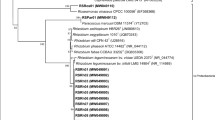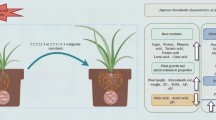Summary
Examination of the root surfaces of Medicago tribuloides Desr. with phase contrast microscopy or electron microscopy using thin sections revealed the presence of a layer of material outside the root surface. In thin sections of KMnO4 fixed roots this layer was composed of a thin electron dense layer, an electron dense granular matrix of varying width and an enclosing electron dense membrane. After inoculation with an effective Rhizobium strain, rhizobia were found aggregated in a definite zone adjacent to the root surface when either living roots were examined by phase microscopy or thin sections by electron microscopy. This layer was also found in inoculated and uninoculated roots of Trifolium fragiferum and T. pratense. The bacteria were packed with inclusion granules and lay enclosed by a membrane layer adjacent to the granular matrix seen in uninoculated roots. The ultrastructural organisation of root hairs is essentially similar to that of other differentiated root cells. The replicated surface of the uninoculated root hair wall is largely amorphous with a few sculptured portions resembling a cuticle layer. The inoculated root hair wall often shows areas of exposed, open microfibrillar meshwork with rhizobia sitting on the microfibrils. The rhizobia resemble a flagellated, coccoid swarmer form of Rhizobium which is found in the barrel medic rhizosphere.
Similar content being viewed by others
Explore related subjects
Discover the latest articles and news from researchers in related subjects, suggested using machine learning.References
Allen, E. K., and O. N. Allen: Biological aspects of symbiotic nitrogen fixation. In. Handbuch der Pflanzenphysiologie 8, 48–118 (1958). Berlin, Göttingen, Heidelberg: Springer.
Allison, F. E.: Azotobacter inoculation of crops 1. Historical. Soil Sci. 64, 413–429 (1947).
Beijerinck, M. W.: Die Bakterien der Papilionaceenknöllchen. Bot. Ztg. 46, 726–804 (1888).
Belford, D. S., a. Myers, and R. D. Preston: Spatial and temporal variation of microfibrillar organisation in plant cell walls. Nature (Lond.) 181, 1251–1253 (1958).
—, and R. D. Preston: The structure and growth of root hairs. J. exp. Bot. 12, 157–168 (1961).
Bewley, W. F., and H. B. Hutchinson: On the changes through which the nodule organism (Ps. radicicola) passes under cultural conditions. J. Agricult. Sci. 10, 144–162 (1920).
Bhaduri, S. N.: The influence of the numbers of Rhizobium supplied on the subsequent nodulation of the legume host plant. Ann. Bot. (Lond.) N.S. 15, 209–217 (1951).
Bissett, K. A., and C. M. F. Hale: The production of swarmers in Rhizobium spp. J. gen. Microbiol. 5, 592–595 (1951).
Burginn-Wolff, A.: Untersuchungen über die Infektion von Wurzeln durch Knöllchenbakterien. Ber. schweiz. bot. Ges. 59, 75–111 (1959).
Cormack, R. G. H.: Development of root hairs in angiosperms. Bot. Rev. 28, 446–464 (1962).
Cullinmore, D. R., and M. Woodbine: A rhizosphere effect of the pea root on soil algae. Nature (Lond.) 198, 304–305 (1963).
Dart, P. J., and F. V. Mercer: Development of the bacteroid in the root nodule of barrel medic (Medicago tribuloides Desr.) and subterraneum clover (Trifolium subterraneum L.). Arch. Mikrobiol. 46, 382–401 (1963).
—, and J. S. Pate: Nodulation studies in legumes. III Aust. J. biol. Sci. 12, 427–444 (1959).
Dart, P. J., J. S. Pate, and R. B. Donnelly: unpublished observations.
Dawes, C. J., and E. Bowler: Light and electron microscope studies of the cell wall structure of the root hairs of Raphanus sativus. Amer. J. Bot. 46, 561–565 (1959).
Doudoroff, M., and R. Y. Stanier: Role of Poly-ß-hydroxybutyric acid in the assimilation of organic carbon by bacteria. Nature (Lond.) 183, 1440–1442 (1959).
Fåhreus, G.: The infection of clover root hairs by nodule bacteria, studied by a simple glass slide technique. J. gen. Microbiol. 16, 374–381 (1957).
Fred, E. B., I. L. Baldwin, and E. McCoy: Root nodule bacteria and leguminous plants. Univ. Wisconsin Studies in Sci. 5, Madison, Wisc. (1932).
Frey-Wyssling, A.: Growth of plant cell walls. Symp. Soc. exp. Biol. 6, 320–328 (1952).
—, and K. Muhlethaler: Über den Feinbau der Zellwand von Wurzelhaaren. Mikroskopie 4, 257–266 (1949).
Hely, F. W., F. J. Bergersen, and J. Brockwell: Microbial antagonism in the rhizosphere as a factor in the failure of inoculation of subterraneum clover. Aust. J. biol. Sci. 8, 24–44 (1957).
Houwink, A. L.: A macromolecular mono-layer in the cell wall of Spirillum spec. Biochim. biophys. Acta (Amst.) 10, 360–366 (1953).
—, and W. van Iterson: Electron microscopical observation on bacterial cytology. II. A study on flagellation. Biochim. biophys. Acta (Amst.) 5, 10–44 (1950).
—, and P. A. Roelofsen: Fibrillar architecture of growing plant cell walls. Acta Bot. Neérl. 3, 385–395 (1954).
Jenny, H., and K. Grossenbacher: Root soil boundaries as seen in the electron microscope. Soil. Sci. Soc. Amer. Proc. 27, 273–277 (1963).
Jensen, H. L.: Nitrogen fixation and cellulose decomposition by soil microorganisms. 1. Proc. Linn. Soc. N.S.W. 65, 543–546 (1940).
—: Bacterial treatment of non-leguminous seeds as an agricultural practice. Aust. J. Sci. 4, 117–120 (1942).
Katzelson, H., J. W. Rouatt, and T. N. B. Payne: The liberation of amino acids and reducing compounds by plant roots. Plant and Soil 7, 35–48 (1955).
Kawamatu, S.: Electron microscope observations on the root hair cell of Azolla imbricata Nakai. Cytologia 28, 12–20 (1963).
Kefford, N. P., J. Brockwell, and J. A. Zwar: The symbiotic synthesis of auxin by legumes and nodule bacteria and its role in nodule development. Aust. J. biol. Sci. 13, 456–467 (1960).
Krasilnikov, N. A.: Soil microorganisms and higher plants. Acad. Sci. U.S.S.R. Moscow. English edition — National Science Foundation (1959).
Kuprevich, V. F.: Extracellular enzymes of roots of higher plants. Report Acad. Sci. U.S.S.R. 18, 953–956 (1949) — quoted in Krasilnikov, N. A.: Soil microorganisms and higher plants, p. 276
Leifson, E., and L. W. Erdman: Flagellar characteristics of Rhizobium species. Antonie van Leeuwenhoek J. Microbiol. Serol. 24, 97–110 (1958).
—, and I. Palen: Variations and spontaneous mutations in the genus Listeria in respect to flagellation and motility. J. Bact. 70, 233–240 (1955).
Ljunggren, H., and G. Fåhreus: Effect of Rhizobium polysaccharide on the formation of polygalacturonase in lucerne and clover. Nature (Lond.) 184, 1578–1579 (1959).
——: The role of polygalacturonase in root-hair invasion by nodule bacteria. J. gen. Microbiol. 26, 521–528 (1961).
Lundegardh, H., and G. Stenlid: On the exudation of nucleotides and flavanone from living roots. Ark. Bot. (Stockh.) 31A, 1–27 (1944).
Mercer, E., and M. S. C. Birbeck: Electron microscopy. A handbook for biologists. Blackwell Scientific Publications. Oxford 1961.
Mollenhauer, H. H., W. G. Whaley, and J. H. Leech: A function of the Golgi apparatus in outer root cap cells. J. Ultrastr. Res. 5, 193–200 (1961).
——: An observation on the functioning of the Golgi apparatus. J. Cell Biol. 17, 222–225 (1963).
Murray, R. G. E.: On the cell wall structure of Spirillum serpens. Canad. J. Microbiol. 9, 381–392 (1963).
—, and A. Birch-Andersen: Specialised structure in the region of the flagella tuft Spirillum serpens. Canad. J. Microbiol. 9, 393–402 (1963).
Nutman, P. S.: Some observations on root-hair infection by nodule bacteria. J. exp Bot. 10, 250–263 (1959).
—: The relation between root hair infection by Rhizobium and nodulation in Trifolium and Vicia. Proc. roy. Soc. B 156, 122–137 (1962).
Nutman, P. S.: Factors influencing the balance of mutual advantage in legume symbiosis. In Symp. Soc. gen. Microbiol. 13, 51–71 (1963).
Purchase, H. F.: Restriction of infection threads in nodulation of clover and lucerne. Aust. J. biol. Sci. 11, 155–161 (1958).
—, and P. S. Nutman: Studies on the physiology of nodule formation. IV. The influence of bacterial numbers in the rhizosphere on nodule initiation. Ann. Bot. (Lond.). N.S. 21, 439–454 (1957).
Roberts, E. A.: The epidermal cells of roots. Bot. Gaz. 62, 488–506 (1916).
Roelofsen, P. A.: The plant cell-wall. Encyclopedia of Plant. Anatomy 3, (4). Berlin-Nikolassee: Gebrüder Borntraeger 1959.
Rovira, A. D.: Plant root excretions in relation to the rhizosphere effect. 1. The nature of root exudate from oats and peas. Plant and Soil 7, 178–194 (1956).
—: Root excretions in relation to the rihzosphere effect. IV. Influence of plant species, age of plant, light, temperature, and calcium nutrition on exudation. Plant and Soil 11, 53–64 (1959).
—: Plant root exudates in relation to the rhizosphere microflora. Soils and Fertilisers 25, 167–172 (1962).
—, and J. R. Harris: Plant root excretions in relation to the rhizosphere effect. V. Exudation of B-group vitamins. Plant and Soil 14, 199–214 (1961).
Salton, M. R. J., and R. C. Williams: Electron microscopy of the cell walls of Bacillus megaterium and Rhodospirillum rubrum. Biochim. biophys. Acta. (Amst.) 14, 455–458 (1954).
Schaede, R.: Die Knöllchen der adventiven Wasserwurzeln von Neotunia oleracea und ihre Bakteriensymbiose. Planta (Berl.) 31, 1–21 (1940).
Schlegel, H. G., u. G. Gottschalk: Poly-ß-hydroxybuttersäure, ihre Verbreitung, Funktion und Biosynthese. Angew. Chem. 74, 342 (1962).
Schroth, M. N., and W. C. Snyder: Effect of host exudates on chlamydospore germination of the bean root rot fungus, Fusarium solani F. phaseoli. Phytopathology 51, 389–393 (1961).
Scott, F. M.: Internal suberisation of tissues. Bot. Gaz. 111, 378–394 (1950).
—: Root hair zone of soil-grown roots. Nature (Lond.) 199, 1009–1010 (1963).
—, B. G. Bystrom, and E. Bowler: Root hairs, cuticle and pits. Science 140, 63–64 (1963).
—, K. C. Hamner, E. Baker, and E. Bowler: Electron microscope studies of cell wall growth in the onion root. Amer. J. Bot. 43, 313–324 (1956).
————: Electron microscope studies of the epidermis of Allium cepa. Amer. J. Bot. 45, 449–461 (1958).
Starr, M. P., and R. C. Williams: Helical fine structure of flagella of a motile diphtheroid. J. Bact. 63, 701–706 (1952).
Thornton, H. G., and N. Gangulee: The life cycle of the nodule organism Bacillus radicicola (Beij) in soil, its relation to infection of the host plant. Proc. Roy. Soc. B 99, 427–451 (1926).
Vincent, J. M., B. Humphrey, and R. J. North: Some features of the fine structure and chemical composition of Rhizobium trifolii. J. gen. Microbiol. 29, 551–555 (1962).
Weibull, C.: Movement. In: The Bacteria, Vol. 1, p. 153–205, Ed. I. C. Gunsalus and R. Y. Stanier. London: Academic Press 1960.
Williams, M. A., and G. B. Chapman: Electron microscopy of flagellation in species of Spirillum. J. Bact. 81, 195–203 (1961).
Wilson, P. W.: The biochemistry of symbiotic nitrogen fixation. Madison, Wis.: Univ. Wis. Press 1940.
Author information
Authors and Affiliations
Rights and permissions
About this article
Cite this article
Dart, P.J., Mercer, F.V. The legume Rhizosphere. Archiv. Mikrobiol. 47, 344–378 (1964). https://doi.org/10.1007/BF00406359
Received:
Issue Date:
DOI: https://doi.org/10.1007/BF00406359




